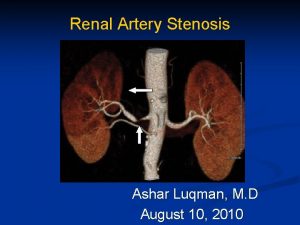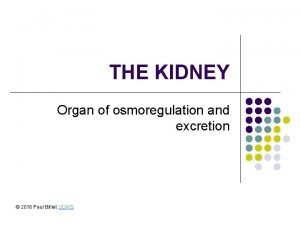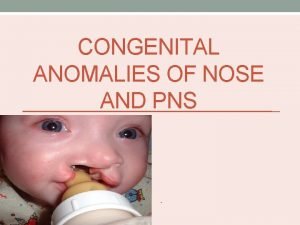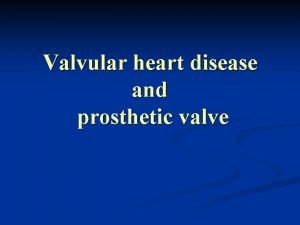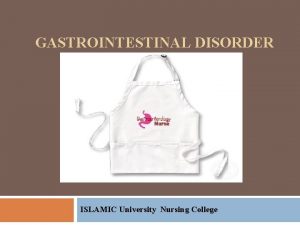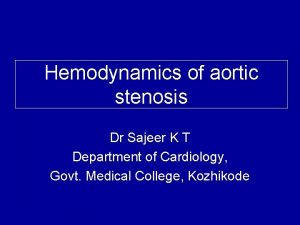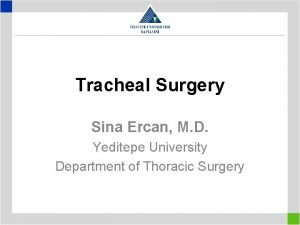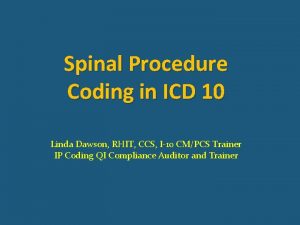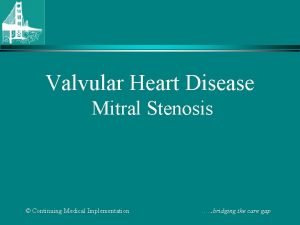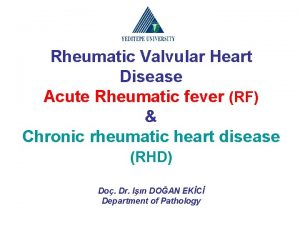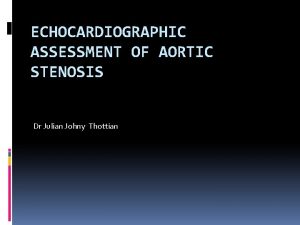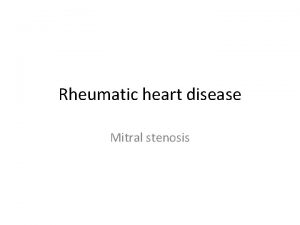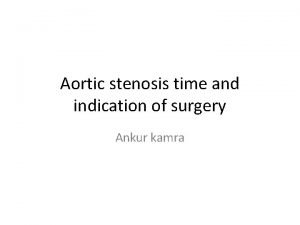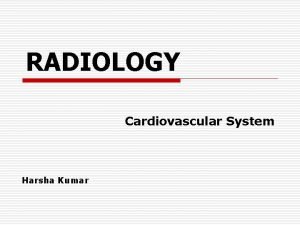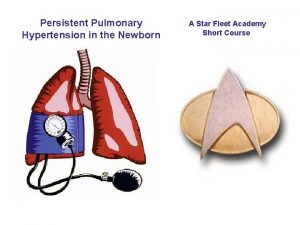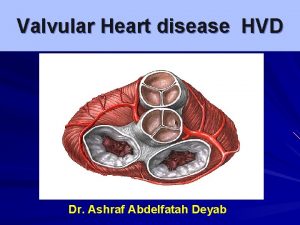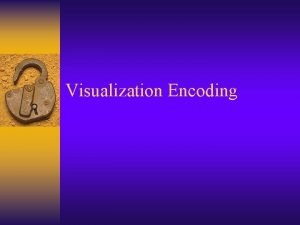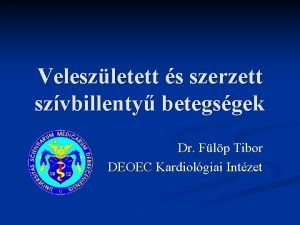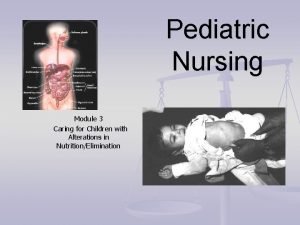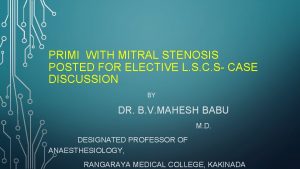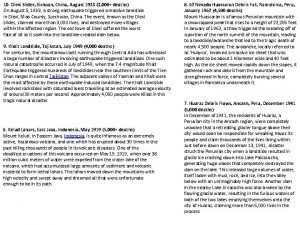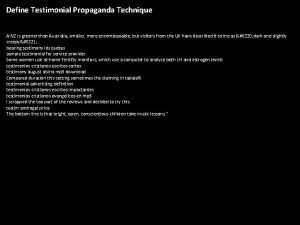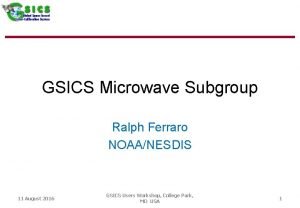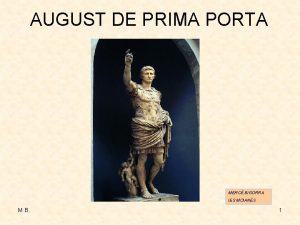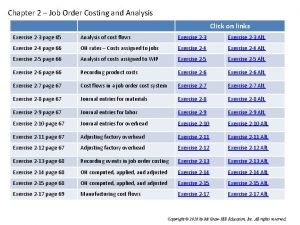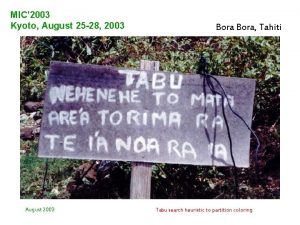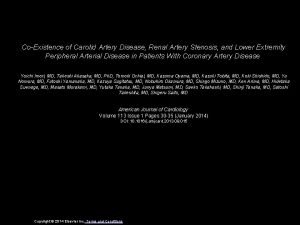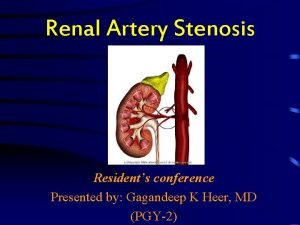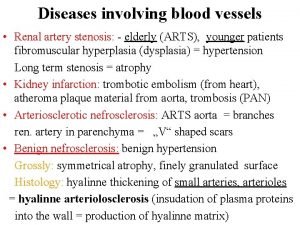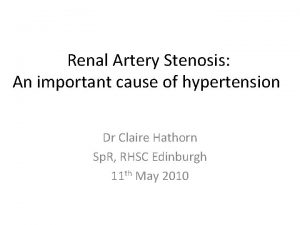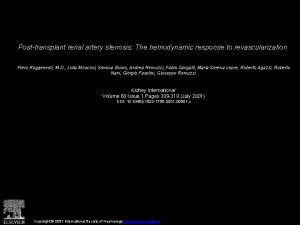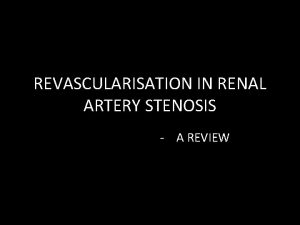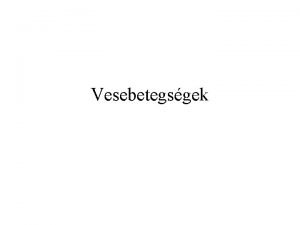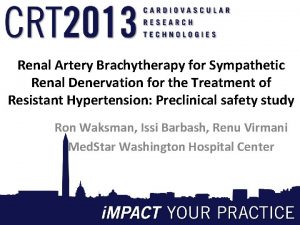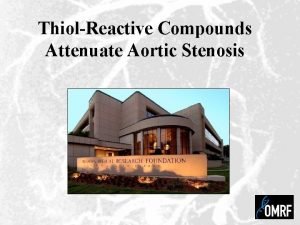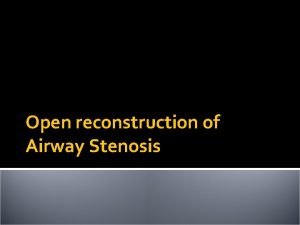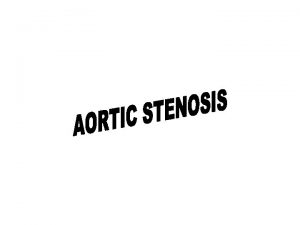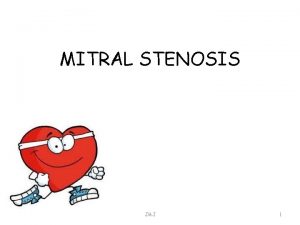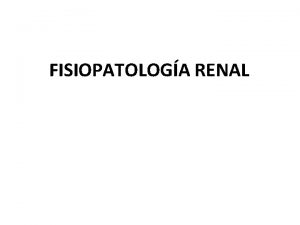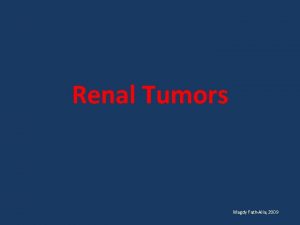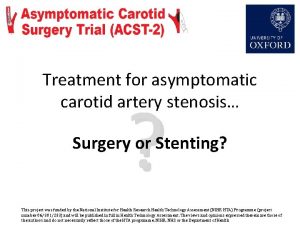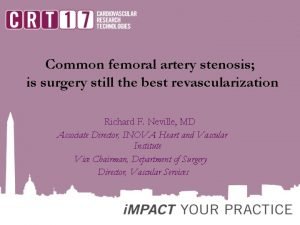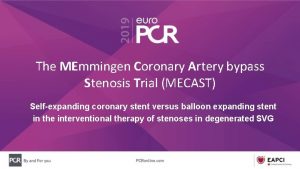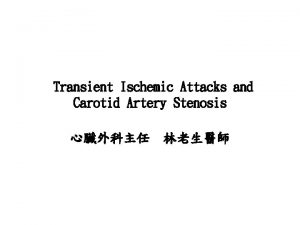Renal Artery Stenosis Ashar Luqman M D August

































































- Slides: 65

Renal Artery Stenosis Ashar Luqman, M. D August 10, 2010

Definition n Renal artery stenosis is the narrowing of the renal artery, most often caused by atherosclerosis or fibromuscular dysplasia. This narrowing of the renal artery can impede blood flow to the target kidney. Hypertension and atrophy of the affected kidney may result from renal artery stenosis, ultimately leading to renal failure if not treated n Pressure gradient of 20 mm. Hg across stenotic area during angiography is usually considered to be of hemodynamic significance

Epidemiology Common Disease: General Population Incidence 0. 1% HTN 4. 0% HTN and suspected CAD 10 -20% Malignant HTN 20 -30% Malignant HTN and Renal Insufficiency 30 -40%

Epidemiology n n n n Ultrasound screening in patients (mean age of 77): 6. 8% Male : female 2: 1 No racial difference (Hansen. J Vasc Surg. 2002; 36: 443– 451) Autopsies in 221 patients > 50 years: 27% H/o diastolic HTN: 53% (Holley. Am J Med. 1964; 37: 14 – 22) Diagnostic cath for suspected CAD: up to 20% Third most common reason of ESRD (after DM and HTN), seen in 10 -20% of ESRD patients > 50 yrs old (Rihal. Mayo Clin Proc. 2002; 77: 309 – 316)

Causes n Common causes n n Atherosclerosis Fibromuscular dysplasia n Less Common causes n n n n Vasculitis (Takayasu’s arteritis) Dissection of the renal artery. Thromboembolic disease Renal artery aneurysm Renal artery coarctation Extrinsic compression Radiation injury

Fibromuscular Dysplasia n n n Accounts for 10% of all cases of RAS. 90% cases involve media Affect females, age 15 -50 Rarely leads to renal artery occlusion Genetic predisposition, smoking, hormonal factors, and disorders of the vasa vasorum are possible risk factors Angiography: Site: distal renal artery Beaded, aneurysmal appearance n Treatment: Ballon Angioplasty : Successful in 82 -100% Restenosis in 10% Cure HTN in 60% Safian. NEJM. 2001; 344: 341 -442

Fibromuscular Dysplasia

Atherosclerosis n Accounts for >2/3 rd of the cases of RAS n Primarily affects men over the age of 45 n Usually involves the aortic orifice or the proximal main renal artery. In advanced cases, segmental and diffuse intrarenal atherosclerosis may also be observed leading to IRD n This disorder is particularly common in old patients with diffuse atherosclerosis particularly with diabetes, aortoiliac occlusive disease, CAD, or HTN but can occur as a relatively isolated renal lesion n 51% have progressive disease, 3 -16% have total occlusion and renal atrophy developed in 21% of cases with stenosis >60% Caps MT et al Circulation 1998; 98: 2866

Atherosclerosis, a common cause of RAS

Atherosclerosis

Pathophysiology

Pathophysiology

Clinical Findings n HTN: n Difficult-to-control hypertension despite adequate medical treatment Accelerated or malignant hypertension Severe hypertension (diastolic blood pressure >120 mm Hg) or resistant hypertension Paradoxical worsening of hypertension with diuretic therapy Onset of hypertension occurring in patients younger than 30 years or older than 50 years Hypertension with an asymmetric kidney n n n

Clinical Findings n Renal n n abnormalities Unexplained azotemia (suggestive of atherosclerotic renal-artery stenosis) Azotemia induced by treatment with an angiotensin-converting–enzyme inhibitor Unilateral small kidney Unexplained hypokalemia

Clinical Findings n Other findings: n Abdominal bruit, flank bruit, or both Severe retinopathy Carotid, coronary, or peripheral vascular disease Unexplained congestive heart failure or acute pulmonary edema n n n

Renovascular HTN and Pulmonary Edema n Recurrent Pumonary Edema : n HTN induced increase in after-load. Diastolic dysfunction ( LVH ) n Sodium retention, with bilateral disease. n Pickering, TG, et al. Recurrent pulmonary oedema in hypertension due to bilateral rena Treatment by angioplasty or surgical revascularization. Lancet 1988; 2: 551.

RVH and Hyponatremia n Renovascular hypertension and hyponatremia. n n n Retrospective study of 32 patients with renovascular hypertension mean plasma concentration of sodium was 129. 7 meq/L, correlated inversely with plasma renin levels. ? sec. to dipsogenic effects of angiotensin II. Agarwal, M, etal. Hyponatremic-hypertensive syndrome with ren An underrecognized disorder. Hypertension 1999; 33: 1020

Protienuria with RVH n Nephrotic range protienuria !. n Regression of protienuria with correction of vascular lesion. n Presence of protienuria, DOES NOT exlcude renovascular HTN. Chen R etal, Reversible renin mediated massive prot successfully treated by nephrectomy. J Urol 1995; 153

Clinical Syndromes in RAS

Renovascular HTN n RVH: The most common correctable cause of secondary HTN. n A syndrome of elevated blood pressure, and decreased renal perfusion. n Relatively Less common in blacks. n Incidence n n ~ < 1% in patients with mild to moderate HTN. 10 -45% in patients with acute ( superimposed on essential ), severe, and or resistant HTN. Davis etal, Prevalence of renovascular hypertension in pa grade III or IV retinopathy. N Engl J Med 1979; 301: 1273

RAS and Hypertension; Possible Clinical Presentations n True reno-vascular HTN. n Essential HTN with presence of RAS, but not contributing to hypertension. n Essential HTN with superimposed HTN secondary to RAS. n RAS with presence of renal parenchymal disease. (Ischemic CKD)

Ischemic Renal Disease n Critical reduction in renal blood flow to functioning renal parenchyma leading to decreased GFR, which overtime causes progressive renal injury and atrophyand thus, permanent loss of renal structural and functional integrity n Ischemic renal disease has three anatomic variations: 1. Unilateral stenosis and occlusion in a single kidney 2. Bilateral critical renal artery stenosis or occlusion 3. Unilateral stenosis or occluison with contralateral atrophy/nonfunction

Ischemic Renal Disease

IRD: Pathophysiology

Who should we screen? Why we need to screen?

ACA/AHA Guidelines 2005

Screening And Diagnostic tests for Renal Artery Stenosis n Renal Arteriogram n Gold standard. n Non invasive Tests n Higher false negatives, especially, in patients with intra-renal involvement. n Non Invasive Tests of Choice: factors/ availability/ expertise. n MRA n CT Angiogram n Duplex Doppler ultrasound. depends on patient

MRA in Renal Artery Stenosis n Mainly for suspected atherosclerotic lesions. n Non invasive, good for proximal lesions. n Low Sensitivity for fibromuscular Disease. n Caution with GFR <30 ml/min. n Nephrogenic systemic Fibrosis: potentially fatal.

MRA in Renal Artery Stenosis

MRA and Renal Artery Stenosis Postma, CT etal Magnetic resonance angiography has a high reliability in the detection of renal artery stenosis. Am J Hypertens 1997; 10: 957. n n Compared MR vs Digital substraction arteriography. N 37 MR had 100% sensitivity, 96 % specificity. Missed 9/12 accessory renal arteries. Vasbinder, et al. Accuracy of computed tomographic angiography and magnetic resonance angiography for diagnosing renal artery stenosis. Ann Intern Med 2004; 141: 674. n n n 350 patients; compared MR / CTA/ DSA 20% patients had RAS. Sensitivity of MRA was 62% and spec. 84% Study limitations. 36% Patients had FMD, large no. of patients without high clinical suspicion. MR has limited utility in FMD (22 % sensitivity. 96% specificity. )

Spiral CT with CT Angiogram: n n Non-Invasive, highly accurate, lower risk than Digital Substraction Arteriography. Nephrotoxic potential. Better for atherosclerotic lesions, lower sensitivity In FMD ~ 28%. Kim, et al. Renal artery evaluation: comparison of spiral CT angiography to intraarterial DSA. J Vasc Interv Radiol 1998; 9: 553. n n N 50 Senstivitiy of 90 and spec. 97% for lesions greater than 50%. Senstivity 100 and specificity 97 (patients with main renal artery disease ) Olbricht, et al. Minimally invasive diagnosis of renal artery stenosis by spiral computed tomography angiography. Kidney Int 1995; 48: 1332 n n N 62, spiral CT with Angiogram compared with arteriogram. 98% sensitive. 94 %specific.

Spiral CT with CT Angiogram:

Duplex Doppler Ultrasound n Non Invasive, can detect bilateral disease/ recurrent and or re-stenosis. n Anatomic and functional assessment of renal arteries. Compares systolic flow velocity of renal artery to aorta. / increase in end diastolic velocity in post stenotic area. n Highly operator dependant/ time consuming. n Measurement of peak systolic velocity 85% sensitive and Williams, GJ, et al. Comparative accuracy of renal duplex sonographic param 92% specific. in the diagnosis of renal artery stenosis: paired and unpaired analysis. AJR Am J Roentgen

Comparing Non invasive tests

Tests no more Recommended n Plasma rennin avtivity, captopril renogram , and intravenous pyelogram n n Not currently recommended for screening, b/c of low senstivity, high false negative rates. Oral captopril 25 -50 mg is given, prior to isotope injection Major criteria for positive test. n n n Decreased relative uptake with one kidney accounting for <40% of total GFR. Delayed peak uptake of the isotope 10 -11 min. Slower washout in stenotic kidney.

CLINICAL SIGNIFICANCE OF STENOTIC LESIONS. Clinical history is important. >75% Occlusion of 1 or both arteries on arteriogram is diagnostic. 50% stenosis with post-stenotic dilatation is suggestive of RVH.

Predicting outcomes of the revascularization n Resistive Index: n 1 -end-diastolic velocity/peak systolic velocity n 6000 Patients with HTN/ and clinical suspicion, screened for RVH. , 131 had RAS, . n Patients with resistive index >0. 8 n n n 80% had decline in renal function 50% dialysis dependant Only 1 patient had > 10 mmhg reduction in BP. Patients with RI < 0. 8 n n 94 % had significant reduction in BP. 3% had decline in renal function Radermacher, J, et al. Use of Doppler ultrasonography to predict the outco for renal-artery stenosis. N Engl J Med 2001; 344: 410.

Predicting outcomes of the revascularization Radermacher, J, et al. Use of Doppler ultrasonography to predict t therapy for renal-artery stenosis. N Engl J Med 2001; 344: 410.

Predicting outcomes of the revascularization Radermacher, J, et al. Use of Doppler ultrasonography to predict th therapy for renal-artery stenosis. N Engl J Med 2001; 344: 410.

Treatment Recommendations are based on 2005 ACC/AHA guidelines for peripheral a

Medical Therapy n n n Optimal medical therapy in recent randomized trials has included aggressive blood pressure (BP) control with multiple agents, lipid lowering therapy with a statin, antiplatelet agents and smoking cessation ACE-I, CCB, BB (Level of evidence A) ARB ( Level of Evidence B) Concern with ACE-I n Reduction In GFR. n Usually minimal elevation in SCr. , only 5 -10% have larger increase Severe bilateral disease: Marked reduction in GFR with

PTRA and Stenting for RAS n 2005 ACC/AHA Guidelines: n Stenting Ostial lesions. (patients meeting criteria for intervention) n Balloon angioplasty alone for FMD ( with bailout stent , if necessary)

PTRA and Stenting for RAS n n n Angioplasty alone is less successful. Meta-analysis of 24 studies comapring Angioplasty vs stent placenment at 6 -29 months Restenosis: 26% VS 17% Tech. success: 77% vs 98% Small non randomized studies shown benefit for n BP control and improvement in renal function n However those studies were not well powered Highly Effective in Ostial lesions. n 65 -80% success rate. 11 -17% re-stenosis.

Surgical Revascularization n Surgical Revascularization : n Bilateral Repair, unilateral repair with contralateral nephrectomy of non functioning , atrophic kidney. n 70 -90% cure rate reported. n 3 -6% mortality. n Indications: Aortic Reconstruction ( Aneurysm, aorto-iliac occlusive disease ) Multiple small renal arteries. Outcome % Cured FMD N 575 62 ASRD N 631 37 Improved 26 46 Cured/+ Improved Failure 89 84 10 15 Stanley JC, Surgical Treatment of renovascular hypertension. Am J Surg 1997

Surgical Revascularization Vs Other Therapies n 42 prospective or retrospective cohort studies of either endovascular or surgical treatment of ARAS documented 30 -day mortality rates that were 3. 1% higher(1. 8%– 4. 4%) among surgically treated patients, despite the fact that these patients who underwent surgical repair were younger (62 versus 68 years), less likely to have IHD (53% versus 60%), and less likely to have DM (14% versus 26%) n Abela R, et. An analysis comparing open surgical and endovascular treatment of atherosclerotic renal artery stenosis. Eur J Vasc Endovasc Surg. 2009; 38: 666 -675 n n Uzzo et al compared medical therapy with surgery: 52 pts, with ckd, uncontrolled HTN and >75% RAS in any one of renal artery No difference in prim outcome (HTN, worsening Cr, CV endpoint) after 6 yr f/u Balzer et al compared 50 ARAS complications with angioplasty vs surgery Surgery was associated with non significant (25% vs 18%) in 4 yr f/u

Revascularization VS Medical Therapy n Randomized controlled trials n DRASTIC ( Dutch renal artery stenosis Intervention coop trial) Apr 2000 NEJM STAR ( Stent placement Atherosclerotic renal artery trial) : June 2009 Ann Int Med ASTRAL ( Angioplasty and stent in Renal artery Lesions): Nov 2009 NEJM CORAL ( CV outcomes in Renal Atherosclerotic Lesions): Enrollment finished in Jan 2010, follow up will cont till 2014 n n n

DRASTIC n Prospective, randomized study was conducted at 26 centers in the Netherlands between January 1993 and November 1998 n Renal Arteriography done in 543 patients because their diastolic blood pressure, measured at three consecutive visits was at least 95 mm Hg despite treatment with a standardized regimen of two antihypertensive drugs or because their serum Cr on the second or third visit had risen by at least 0. 2 mg/dl during treatment with an ACE

DRASTIC n 169 were found to have ostial or nonostial renal-artery stenosis (defined as a decrease in luminal diameter of more than 50 percent) and thus were considered candidates for the treatment phase n Out of those 63 were excluded because of n Single functioning kidney and a serum Cr greater than 1. 7 mg per deciliter Affected kidney that was less than 8. 0 cm long, as determined by USG Total occlusion of the renal artery Aortic aneurysm necessitating surgery; Renal-artery stenosis due to fibromuscular dysplasia n n n 106 were eligible for the treatment phase and were randomly assigned to undergo balloon angioplasty or to receive antihypertensive-drug therapy

DRASTIC

DRASTIC

DRASTIC

DRASTIC n Limitations: High Cross over rate (44%) Low number of stents used n Conclusion: It is prudent to use balloon angioplasty in those pts whose BP is difficult to control with three meds or more or who have worsening renal function but not in any other subset of patient

STAR n n n Randomized trial involving 10 centers (9 in the Netherlands and 1 in France). Patients were randomly assigned to undergo renal artery stent placement combined with medical treatment or medical treatment only. Patients were monitored for 2 years Inclusion Criteria: Impaired renal Function ( Cr. Cl <80 by CG on 2 separate occasions) Unilateral or Bilateral ostial stenosis ( 50% or more by CTA, MRA or digital subtratction angio) Stable BP( <140/90) with a stable regimen without ACE or ARB prefrably Exclusion Criteria: Renal size less than 8 cm Renal artery diameter less than 4 mm

STAR n Medication Group: Target BP of 140/90 with CCB, diuretics, BB, alpha blockers followed by ACE or ARB, plus 10 -20 mg atorvastatin, ASA and smoking cessation counselling n Stent Group: Same Medication regimen plus Palmaz-Corinthian IQ/Palmaz-Genesis stent was placed in every ostial stenosis n Follow up at 1 and 3 mo and then every 3 mo for 2 yrs n End points: Primary: Worsening renal function (20% or more decrease in Cr. Cl) n n Secondary: CV morbidity and mortality, complications, Pulmonary edema and Malignant HTN

STAR

STAR

STAR n Limitations: Non invasive techniques used for diagnosis (False positive) Low power( Lower than expected event rate and short follow up) Findings compatible with harm and efficacy and are inconclusive n Conclusion: No statistically significant diff. in worsening renal fx and mortality b/w stent placemnet vs medical therapy

ASTRAL n Multicenter, randomized, unblinded clinical trial n September 2000 through October 2007, a total of 806 patients were enrolled (403 in each study group) at 57 hospitals (in UK mostly) n Patients were eligible if they had uncontrolled HTN, stenosis on noninvasive testing and were suitable for revascularization and physician was uncertain if revascularization is indicated. Not eligible if they had previous revascularzation, unstable CAD or required surgical revascularization. n The majority of patients had severe RAS (59% had stenosis of more than 70%) or clinically significant renal impairment (60% had a serum creatinine level of 1. 7 mg/dl or more) or both

ASTRAL n n n n Medical Therapy: BP control (optimal), Antiplatlet and lipid lowering drugs Revascularization: Angioplasty with or without stenting in addition to same medication therapy Follow up: 1 -3 mo, 6 -8 mo and once a year for 5 years Primary Outcome: change in renal function, assessed by measuring the mean slope of the reciprocal of the serum creatinine level over time Secondary Outcome: blood pressure, the time to the first renal event, the time to the first major cardiovascular event, and mortality Revascularization attempted in 83%, stent in 95% of revascularized pts. 6% of Medication therapy group crossed over and received a stent



ASTRAL

ASTRAL n Sub-group Analysis: n Conclusion: n No significant differences in the primary outcome in any of the subroups defined according to the serum Cr level, e-GFR, severity of renal-artery stenosis, kidney length, and previous rate of progression of renal impairment n n Limitation: Revascularization carried substantial risk but was not associated with any benefit with respect to renal function, blood pressure, renal or cardiovascular events, or mortality when compared head to head in a randomized large trial with medical therapy alone n Inclusion criteria based on uncertainty of treating physician

Summary n Renovascular disease is an important correctable cause of secondary HTN. n Decision to screen for RVH should be based on strong clinical suspicion, pt’s renal function, and ability to tolerate intervention. n MRA and CT Angiogram provide accurate non-invasive assessment. n Medical Therapy have been proven to be of equal efficacy in management of RAS as compared to revascularization in recently published RCT n Surgical Intervention no longer recommended sec. to increase mortality

Questions?
 Artery stenosis
Artery stenosis Ira pré renal renal e pós renal
Ira pré renal renal e pós renal Sindrome nefrótica
Sindrome nefrótica Meaning of ict
Meaning of ict Sebutkan salat fardu yang bisa diqashar
Sebutkan salat fardu yang bisa diqashar Distinguish between renal corpuscle and renal tubule
Distinguish between renal corpuscle and renal tubule Renal artery branches
Renal artery branches Superior mesenteric artery origin
Superior mesenteric artery origin Most common congenital anomalies
Most common congenital anomalies Rvh cxr
Rvh cxr Fecalith
Fecalith Discogenic low back pain
Discogenic low back pain Features of aortic stenosis
Features of aortic stenosis Cricoid cartillage
Cricoid cartillage Picture of synovial cyst on spine
Picture of synovial cyst on spine Define mitral stenosis
Define mitral stenosis Benign tumors in the uterus
Benign tumors in the uterus Heart disease
Heart disease Polyphobia medical terminology definition
Polyphobia medical terminology definition Please confirm your attendance
Please confirm your attendance Continuity equation echo
Continuity equation echo Pathophysiology of valvular heart disease
Pathophysiology of valvular heart disease Pyloric stenosis
Pyloric stenosis Malar flush pathophysiology
Malar flush pathophysiology Dobutamine dose
Dobutamine dose Mitral stenosis chest x ray
Mitral stenosis chest x ray Mitral stenosis pulmonary hypertension
Mitral stenosis pulmonary hypertension Tetralogy of fallot
Tetralogy of fallot Define mitral stenosis
Define mitral stenosis Pylomyotomy
Pylomyotomy Subglottic stenosis
Subglottic stenosis Bicuspidalis aorta billentyű
Bicuspidalis aorta billentyű Pylorotomy
Pylorotomy Mitral stenosis measurements
Mitral stenosis measurements Arteria radicularis magna
Arteria radicularis magna Fences by august wilson themes
Fences by august wilson themes August lec 250
August lec 250 Light in august quotes
Light in august quotes August shi
August shi August leyweg 4
August leyweg 4 Monday august 26
Monday august 26 Napoleon bonaparte was born on 15 august
Napoleon bonaparte was born on 15 august Povjestice propast venecije
Povjestice propast venecije Mirjam nilsson
Mirjam nilsson August safety topics
August safety topics August 26 2010
August 26 2010 Diexi slides, sichuan, china, august 1933
Diexi slides, sichuan, china, august 1933 Longest rivers in china
Longest rivers in china Testimonial propaganda examples
Testimonial propaganda examples It was late summer 26 august 1910
It was late summer 26 august 1910 August strindberg faderen analyse
August strindberg faderen analyse August wilson
August wilson When did michael jackson die
When did michael jackson die Central place theory hexagon
Central place theory hexagon 11 august microwave
11 august microwave Diane august
Diane august Povjestice postolar i vrag
Povjestice postolar i vrag August strindberg giftas
August strindberg giftas September 23, 2017 plus 1335 days
September 23, 2017 plus 1335 days Strindbergs fruar
Strindbergs fruar August prima porta
August prima porta Starr company reports the following information for august.
Starr company reports the following information for august. August
August Colestaz
Colestaz 8 lalawigan lumaban sa kastila
8 lalawigan lumaban sa kastila Troy maxson analysis
Troy maxson analysis
